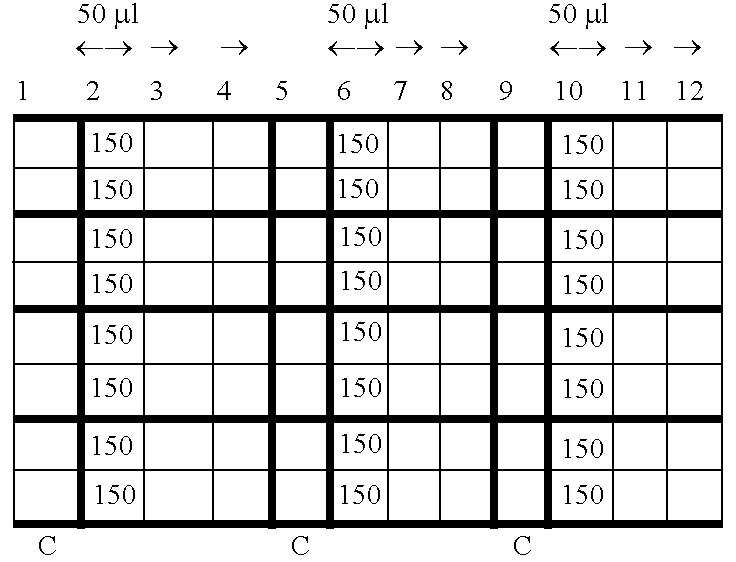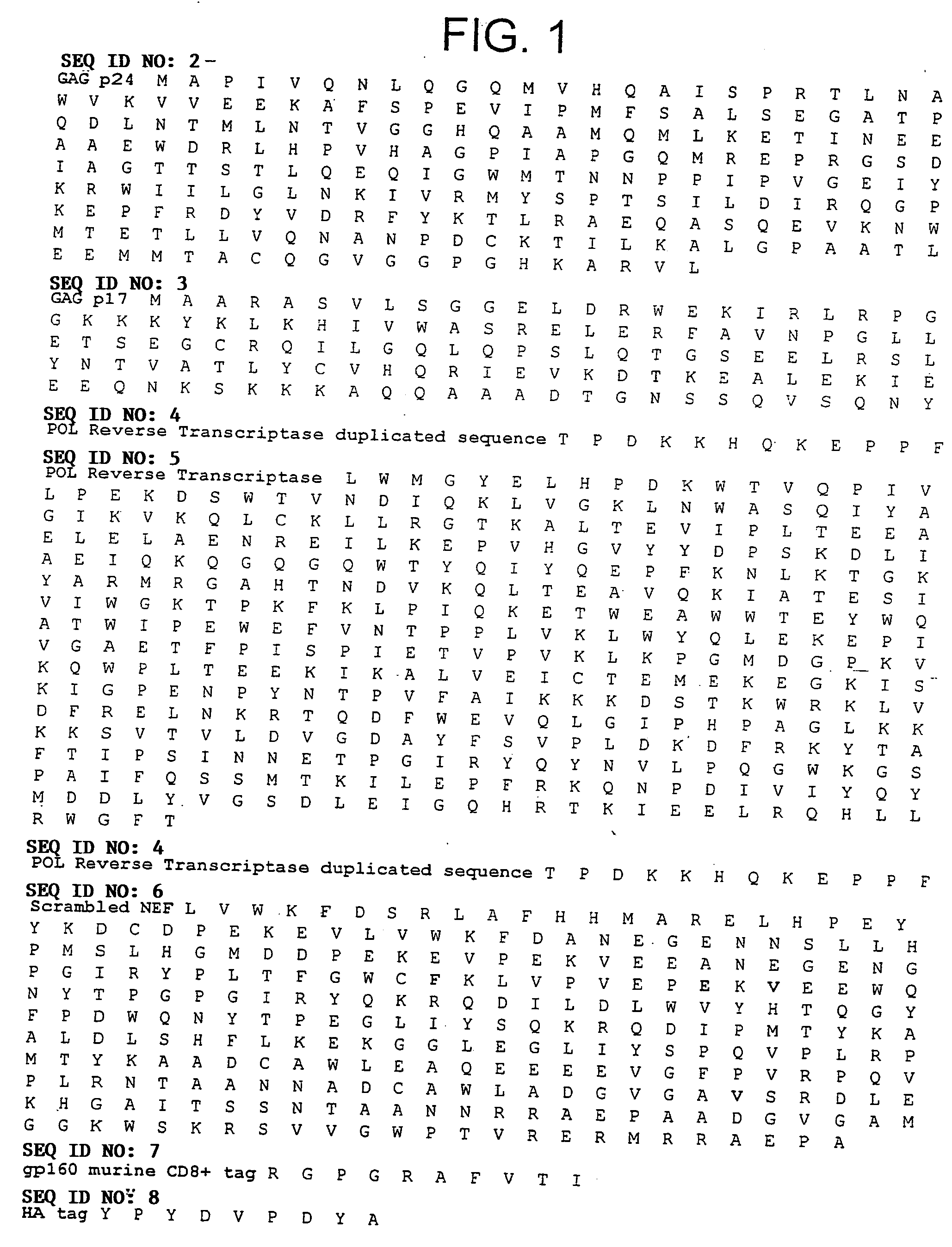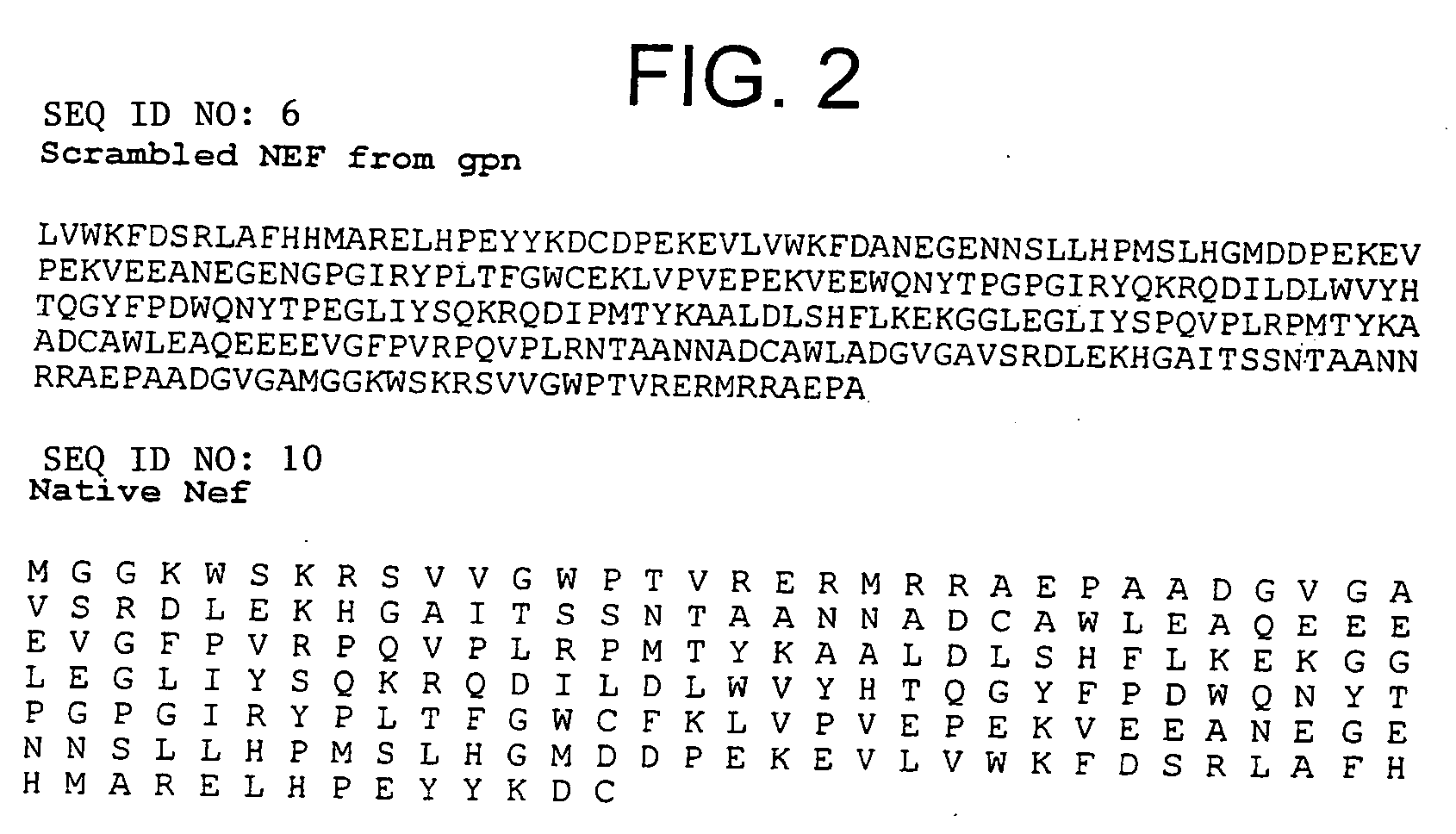HIV pharmaccines
a technology of pharmaccines and hives, which is applied in the field of hives, can solve the problems of reducing the immune response, reducing the number of patients, so as to improve the immune response, increase the number, and reduce the risk of hiv particles being used in vaccines
- Summary
- Abstract
- Description
- Claims
- Application Information
AI Technical Summary
Benefits of technology
Problems solved by technology
Method used
Image
Examples
example 1
Analysis of CD8+ T Cell and T Helper Epitopes in the GPN Sequence
[0183] We used ProPred to compare T helper epitopes for native NEF versus scrambled NEF. This program predicts that there are more T helper epitopes in scrambled NEF according to the present invention. This demonstrates that the scrambled NEF sequence is at least as potent in eliciting T helper and CD8+ T cell responses as native NEF.
CD8+ T Cell Epitopes
[0184] CD8+ T cells can recognise and eliminate virally-infected T cells and have been associated with control of viraemia in HIV infection in man and SIV infection in monkeys.
[0185] Comparison of the GPN sequence (FIG. 1) with the HXB2 reference sequence published in the HIV molecular immunology database (“HIV Molecular Immunology 2002: Maps of CD8+ T cell Epitope Locations Plotted by Protein” Theoretical Biology and Biophysics, Los Alamos National Laboratory. Aug. 7, 2003; http: / / hiv-web.lanl.gov / content / immunology / maps / ctl / ctl.pdf) is performed.
[0186] This comp...
example 2
Recombinant GPN Gene in DNA, MVA and Fowlpox
[0196] A recombinant gag-pol-nef (gpn) gene is constructed for expression of a GPN fusion protein. This gene construct is used in nucleic acid carrier such as DNA carrier (e.g., plasmid carrier), as well as in MVA and fowlpox vectors and materials for construction of same.
[0197] The use of recombinant virus vectors such as MVA and / or fowlpox vectors to boost a DNA plasmid-mediated prime has been shown to induce a strong immune response in rodents.
[0198] Essentially the same constructs also find application in primates such as humans.
[0199] In this example, the therapeutic antigen delivered by the recombinant pox viruses comprises a fusion protein based on the products of the products of the HIV-1 clade-B gag, pol and nef genes.
[0200] The recombinant gag-pol-nef gene was synthesized as a series of overlapping oligonucleotides, amplified by use of polymerase chain reaction cloned into the commercially available plasmid, pUC19, to make p...
example 3
Immunisation with FP9.gpn and MVA.gpn Elicits Antigen Specific CD8+ T Cell Responses
[0236] In this example, it is demonstrated that FP9.gpn and MVA.gpn elicit enhanced antigen-specific CD8+ T cell responses when administered alone or in a prime-boost immunization regimen with pSG2.gpn. In this example, the demonstration is presented in mice.
[0237] Female BALB / c mice (6-8 weeks old) are immunized with 50 μg of pSG2.gpn by intramuscular (im.) injection and boosted with 1×106 PFU FP9.gpn or 1×105 MVA.gpn by intravenous injection (iv.) two weeks later. A further group of age matched naive female BALB / c mice are immunized iv. with 1×106 PFU FP9.gpn or 1×105 MVA.gpn at the same time as the booster immunization.
[0238] Fourteen days after the booster immunization, all mice are sacrificed by cervical dislocation and the T cell response elicited against three H-2d restricted CD8+ epitopes from the GPN polypeptide (Table A: AMQ, TTS, RGP) is determined by IFN-γ ELISpot assay as described be...
PUM
| Property | Measurement | Unit |
|---|---|---|
| molecular weight | aaaaa | aaaaa |
| molecular weight | aaaaa | aaaaa |
| nucleic acid | aaaaa | aaaaa |
Abstract
Description
Claims
Application Information
 Login to View More
Login to View More - R&D
- Intellectual Property
- Life Sciences
- Materials
- Tech Scout
- Unparalleled Data Quality
- Higher Quality Content
- 60% Fewer Hallucinations
Browse by: Latest US Patents, China's latest patents, Technical Efficacy Thesaurus, Application Domain, Technology Topic, Popular Technical Reports.
© 2025 PatSnap. All rights reserved.Legal|Privacy policy|Modern Slavery Act Transparency Statement|Sitemap|About US| Contact US: help@patsnap.com



